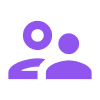The planning conversation, also known as the goals conversation, takes place at the start of the traditional HR cycle. The planning meeting determines what the goals for the upcoming period will be. Yet a quarter of employees have no idea how they can contribute to company goals. How do you make sure the objectives are aligned?
In this blog, you will read what the planning conversation is all about, the pros and cons of the planning conversation and how to set concrete goals. We’ll give you practical tips for both the supervisor and the employee to properly prepare for the planning interview and give the employee more responsibility. Learn, among other things, how to revamp the planning interview and make it resistant to the rapidly changing marketplace with the sample planning interview questions. ing conversation, focusing on employee growth and development.
What is the planning interview?
The planning interview is the first official conversation in the traditional HR cycle, which consists of the planning, performance and assessment interview. The conversation is also called the “goals conversation,” because in this conversation, the supervisor and the employee determine what the goals for the upcoming period will be. During this, both parties express their expectations and then the goals are set. At another time, such as later in the performance or assessment interview, this is reflected on. The type of organization determines the type of goals that are established, but the most commonly discussed topics during the planning conversation are: employee development goals and goals that produce business results. For example, questions can be discussed with the employee in the planning interview such as: what core values, competencies or skills would you like to develop? Or how can you contribute to organizational and team goals?
Trends in the market
The planning conversation is seen as the starting point of the traditional HR cycle. And while 95% of managers report dissatisfaction with the traditional interview cycle (CEB, 2015), that does not necessarily mean that as an HR professional you should completely eliminate the planning conversation from this cycle. Indeed, once conversations are eliminated from the HR cycle, the structure that many managers benefit from disappears. This results in up to 14% lower quality of the remaining calls. This leaves employees to their own devices and reduces productivity by 10% (Gartner, 2018).
Room for growth in the planning conversation
Still, there are a lot of opportunities for growth. Both the company and the employee need concrete goals to pursue. This ensures a common focus and proper expectation.
Four reasons to communicate your company’s goals to your employee before the planning meeting:
- A quarter of employees (25%) have no idea what the company goals are and how they can contribute to them (Protime);
- Only 13% of employees feel that their organization’s leadership communicates effectively with the rest of the organization (Gallup, 2017);
- Millennials value working for a company with a vision, and they want to see how they can contribute to it (Gallup, 2016);
- If employees can link their goals to the goals of the organization, they are 3.5 times more likely to be engaged with the organization (Gallup, 2019).
Rapidly changing market and the planning conversation
The market is changing rapidly. Company goals can therefore be constantly changing, and this can make it difficult to set annual goals for the employee during the planning meeting. Still, it is important to monitor the development of both the organization and the employee, as 85% of companies expect to have a skills shortage within 3 years (WEF, 2020). By increasing the frequency of calls, more realistic goals can be set for a shorter period of time and results can also be achieved sooner. You can also see this in the trend of the agile* method that many companies are now using. An excellent way to translate corporate goals into employee goals are OKRs.
*Agile = agile and flexible organizing. The organization is aware that circumstances change rapidly.
A quarter of employees have no idea how to contribute to company goals
9 Tips to boost the planning conversation
The following are practical solutions to the most common scheduling interview situations faced by HR departments:
Tip 1: Increase the frequency of the planning meeting.
In a traditional HR cycle, a planning meeting is held at the beginning of the year. This conversation sets business and development goals for employees. However, the world is changing faster and faster. Goals set at the beginning of the year are often outdated after a few months.
At Learned, we therefore work with the methodology of The Good Conversation quarterly. By meeting quarterly, we have integrated the HR cycle with our business. Employee goals align with the organization’s quarterly goals. In the quarterly conversation, we reflect on the past quarter. Among other things, we look back at the progress of the business goals and the development agreements the employee would be working on. This allows us to make quick adjustments and/or express appreciation. In addition, the employee is challenged to set his or her goals for the upcoming quarter. How does the employee think they can contribute to Learned’s growth?
By working with the Learned platform vs. old-fashioned forms and back-and-forth emailing, we manage to save time that we then use to have a good conversation every quarter, instead of once a year.
Tip 2: Put the employee in the lead
Too often a top-down methodology still prevails. Do you notice that your employees are not sufficiently challenged to define their own goals? By having employees think about their goals beforehand, they come to the interview well prepared. The question forms in Learned get this process started. Employees receive a task to think firmly in advance of the interview about, for example, the questions below:
- What can you do well?
- What gives you the greatest job satisfaction?
- What do you prefer to do in your work?
- What do you want to develop further?
Both prior to the interview and during the interview, the employee and manager can add the agreed-upon objectives directly into the interview form.
(For more sample questions, download the e-guide that includes a sample form for the revamped planning interview).
Tip 3: Offer your managers structure
Do managers find it difficult to have a good planning conversation? We at Learned recommend supporting managers in having a good conversation, for example, by providing a structured conversation form. The Learned platform has 10+ forms ready for the user who is registered as a “coach. Especially for the inexperienced manager, it can add more structure and quality to the conversation. Add your own OKR or SMART goals to the form? No problem!
Tip 4: Give employees insight into how they are making an impact
One of the key drivers of employee engagement is “making an impact.” Do employees feel that they contribute to the success of the organization?
Use the planning conversation to give employees insight into the organization’s key goals and help them determine their impact. With Learned, you make company goals visible to all your employees and then translate them into team and employee goals. This way, you challenge employees to set goals that contribute to the goals of the organization. This is also called Goal Cascading*.
* Goal Cascading= “tiered goals. These are goals that are translated from one level of the organization to the next. For example, organizational goals translated into team goals and employee goals. The purpose of this method is to align all goals and ensure that the goals align with the organization’s strategy. That way, employees know what is expected of them and results can be clearly communicated. This avoids confusion about who is responsible for the goal, when it should be achieved and how it will be achieved.
Tip 5: Leverage the talents of your employees
Before setting goals in the planning interview, it is wise to first find out what the employee likes, is good at or what energizes him or her. The chances of achieving the goals are then much higher. Indeed, employees who talked to their manager about their goals and successes in the past six months are 2.8 times more likely to be engaged than other employees (Gallup, 2020).
Tip 6: Help employees set concrete and actionable goals
It’s best to set the goals for the planning meeting using the SMART model or through the OKR method. Because by making the goal as concrete as possible, it becomes very clear what the expected results are that will be discussed in subsequent conversations, such as the progress, performance or The Good Talk, for example. Create goals in Learned’s goals module and make them concrete by assigning them to an employee with a closing date.
How do I create a goal using the SMART method?
SMART stands for Specific, Measurable, Acceptable, Realistic and Time-bound. A goal that meets all the SMART points is concrete enough to work with and has a clear end point. That means these goals provide enough structure to evaluate in all subsequent conversations. For example, in the year-end interview where the employee’s skills and competencies are discussed.
Sample SMART goal: “I want a minimum of 3 appointments per week via LinkedIn by the end of March.”
Tip #1: During the year-end interview, evaluate the SMART goal set from the planning interview with the skills and competencies. Looking back on this can provide new input and inspiration.
Tip #2: Ask the employee subtle questions before the planning meeting to get the employee’s thought process started beforehand.
How do I create a goal with the OKR method?
OKR stands for the English terms: Objective and Key Results. The method is determined by two main factors: objectives and key outcomes. Objectives are meant to motivate and inspire the organization and they should be recognizable, realistic and brief. Simply everyone in the organization must be able to understand them. Key results tell what has been done to reach the goals and what remains to be done. Like the objectives, the results should also be short and sweet. A good benchmark to have is about two to five measurable and transparent key outcomes for each objective. Even minimal use of OKRs leads to higher levels of performance. This was evident, for example, in the sale of Sears Holdings. When they used OKRs, they sold up to 8.5% more per hour!
Tip 7: Link performance management with Learning & Development
Does the planning interview reveal that the employee wants to develop further in a particular skill? In the previous chapter, we discussed making a goal SMART. One of the most user-friendly method is to provide the employee with instant insight into the relevant available learner offerings.
Many organizations today work with an online learning platform, for example: Hoodhabitz, Skilltown, Studytube, Newheroes and Lepaya.com. However, employees often do not know how to make the connection between their learning goals and the learning offerings.
With the Learned platform, when employees set up their learning goal, we help them immediately suggest the relevant learning offerings from the learning platforms as an activity to achieve the learning goal. The right learning offer, to the right employee at the right time.
Tip 8: Set goals
Chances are that the conversation will not continue if goals are not established. Are you still working without a system? Then record your goals in a PDF form. However, the chances are that the call will not be followed up. PDF forms quickly disappear into a drawer or they get lost completely. With the Learned platform, we help our clients store objectives and conversation reports in a central location.
Tip 9: Keep goals top-of-mind
Beautifully, you captured your goals. Now you want to avoid not looking at the goals until the next call. Therefore, goals at Learned are discussed on an ongoing basis in the 1:1’s between manager and employee. In the Learned platform, the manager can immediately see what progress the employee has achieved. We also review the status of organizational and team goals with the entire team once a month. We call this the “bear & updates. This way everyone knows what the main objectives are, where the status of the goals can be found and how they can best contribute to them.
Learned HR software usage survey – (Q3) 2021.
- 8 in 10 users found it easier to prepare and conduct interviews;
- 6 in 10 users make more calls;
- 8 in 10 users find conversations more valuable.
Example of a renewed planning meeting
Want to give the planning conversation more structure? We wrote out sample questions for you in the sample planning conversation form. The form includes best practices for business goals, learning objectives and tips for formulating goals in a measurable and concrete way.
Get to work! Download the sample new-style planning meeting form.




























